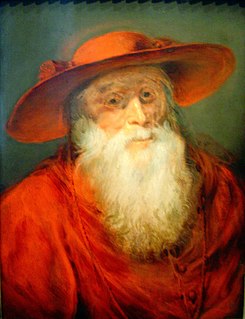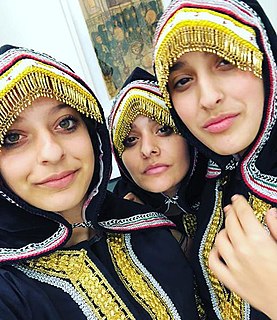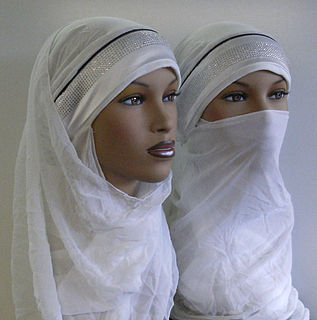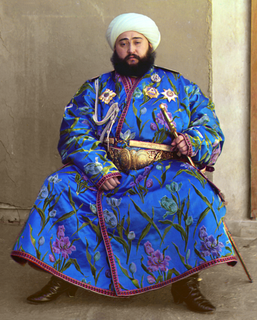 W
WThe biretta is a square cap with three or four peaks or horns, sometimes surmounted by a tuft. Traditionally the three-peaked biretta is worn by Catholic clergy and some Anglican and Lutheran clergy. A four-peaked biretta is worn as academic dress by those holding a doctoral degree from a pontifical faculty or pontifical university or faculty. Occasionally the biretta is worn by advocates in law courts, for instance the advocates in the Channel Islands.
 W
WA camauro is a cap traditionally worn by the Pope of the Catholic Church.
 W
WChristian head covering, also known as Christian veiling, is the traditional practice of women covering their head in a variety of Christian denominations. Some Christian women, based on Orthodox, Roman Catholic, Lutheran, Moravian, Anglican, Reformed, Methodist, and Quaker teaching, wear the head covering in public worship and during private prayer, while others, especially Anabaptist Christians, believe women should wear head coverings all the time in the reflection of the Saint Paul's words that Christians are to "pray without ceasing".
 W
WA colander is a kitchen utensil used to strain foods such as pasta or to rinse vegetables. The perforated nature of the colander allows liquid to drain through while retaining the solids inside. It is sometimes also called a pasta strainer or kitchen sieve.
 W
WA cornette is a piece of female headwear. It is essentially a type of wimple consisting of a large, starched piece of white cloth that is folded upwards in such a way as to create the resemblance of horns on the wearer's head. It remained fashionable for some Parisian ladies around 1800, wearing ones made of muslin or gauze and richly ornamented with lace.
 W
WA dastār which derives from dast-e-yār or "the hand of God", is an item of headwear associated with Sikhism, and is an important part of Sikh culture. The word is loaned from Persian through Punjabi. In Persian, the word dastār can refer to any kind of turban and replaced the original word for turban, dolband (دلبند), from which the English word is derived.
 W
WA galero is a broad-brimmed hat with tasselated strings which was worn by clergy in the Catholic Church. Over the centuries, the red galero was restricted to use by individual cardinals while such other colors as green and violet were reserved to clergy of other ranks and styles.
 W
WGargush is a traditional Yemenite Jewish headdress, resembling a hood, which is thought to have originated in the Sanaite community.
 W
WThe term jilbāb or jilbaab refers to any long and loose-fit coat or outer garment worn by some Muslim women. Wearers believe that this definition of jilbab fulfills the Quranic choice for a hijab. Jilbab, jubbah or jilaabah is also known as chador by Persian speakers in Iran and Afghanistan. The modern jilbāb covers the entire body. Some women will also cover the hands with gloves and the face along with a niqāb. In recent years, a short visor is often included to protect the face from the tropical sun.
 W
WA kippah, also called a koppel or yarmulke, is a brimless cap, usually made of cloth, traditionally worn by Jewish males to fulfill the customary requirement that the head be covered. It is worn by men in Orthodox communities at all times. Among non-Orthodox communities, those who wear them customarily do so only during prayer, while attending a synagogue, or in other rituals. Most synagogues and Jewish funeral parlors keep a ready supply of kippot.
 W
WIn Ashkenazi Jewish tradition, a kolpik is a type of traditional headgear worn in families of some Chassidic rebbes of Galician or Hungarian dynastic descent, by their unmarried children on the Sabbath (Shabbat), and by some rebbes on some special occasions other than Shabbat or major holidays. The kolpik is made from brown fur, as opposed to a spodik, worn by Polish chassidic dynasties, which is fashioned out of black fur. The shtreimel, another similar type of fur hat worn by Hasidim, are shorter in height, wider, and disc-shaped, while kolpiks are taller, thinner in bulk, and of cylindrical shape.
 W
WThe mitre or miter, is a type of headgear now known as the traditional, ceremonial headdress of bishops and certain abbots in traditional Christianity. Mitres are worn in the Catholic Church, Eastern Orthodox Church, Oriental Orthodox Churches, the Anglican Communion, some Lutheran churches, for important ceremonies, by the Metropolitan of the Malankara Mar Thoma Syrian Church, and also, in the Catholic Church, all cardinals, whether or not bishops, and some Eastern Orthodox archpriests.
 W
W"Mohair berets" is a tongue-in-cheek expression that stands for people who support the views expressed by the Polish conservative-nationalistic Catholic movement, whose main representative is Father Tadeusz Rydzyk. This expression originated from the characteristic headgear worn by the stereotypical representatives of this circle.
 W
WThe Philippi Collection is a collection of clerical, religious and spiritual headdresses. The collection demonstrates the history, shared roots and diversity of religious-clerical head coverings.
 W
WThe priestly mitre or turban was the head covering worn by the High Priest of Israel when he served in the Tabernacle and the Temple in Jerusalem.
 W
WThe shovel hat was a style of hat formerly associated with the Anglican clergy, particularly archdeacons and bishops.
 W
WA shtreimel is a fur hat worn by some Ashkenazi Jewish men, mainly members of Hasidic Judaism, on Shabbat and Jewish holidays and other festive occasions. In Jerusalem, the shtreimel is also worn by Litvak Jews. The shtreimel is generally worn after marriage, although it may be worn by boys after bar-mitzvah age in some communities.
 W
WA spodik is a tall, black fur hat worn by some Hasidic Jews, particularly by members of sects in 19th-century Congress Poland. The origins of the spodik and the shtreimel are unclear, but it is often thought that the Jews living in Europe adopted wearing fur hats from the Eastern European culture, and perhaps from the nobility, replacing the sudra.
 W
WSudra is a piece of cloth usually worn as a scarf or headdress as part of ancient Jewish tradition. Over time it held many different functions and today is sometimes understood to be of great cultural or religious significance to Jews. It is mentioned in various ancient and medieval Aramaic and Greek texts written in or about the Near East among them the Gospel of Luke from around 80–110 CE, the Peshitta from the 1st-2nd century, the Targum Neofiti from around the 1st-4th century, the Babylonian Talmud which was completed around 500 CE – this text makes numerous mentions of the sudra and is an important source for its role in Jewish life at the time – and the Targum Pseudo-Jonathan dated between the 4th century and the 14th century.
 W
WTefillin or phylacteries, is a set of small black leather boxes containing scrolls of parchment inscribed with verses from the Torah. Tefillin are worn by observant adult Jews during weekday morning prayers. In Orthodox communities, they are worn solely by men, while some Reform and Conservative (Masorti) communities allow for them to be worn by both men and women, strictly speaking, for any 'time bound' commandment women are absolved from.
 W
WA turban is a type of headwear based on cloth winding. Featuring many variations, it is worn as customary headwear by people of various cultures. Communities with prominent turban-wearing traditions can be found in the Indian subcontinent, Southeast Asia, the Arabian Peninsula, the Middle East, the Balkans, the Caucasus, Central Asia, North Africa, West Africa, East Africa, and amongst some Turkic peoples in Russia as well as Ashkenazi Jews.
 W
WAn umqhele is a traditional Zulu circular headband made of fur. Imiqhele were worn by Zulu men prior to colonization of South Africa, especially by soldiers and elites, and are worn by male members of the Nazareth Baptist Church. They are also worn by Ndebele people, who make them from the tails of cattle. Nazareth Baptist Church imiqhele are frequently made from the fur of leopards, deer, or serval.
 W
WA wimple is a medieval form of female headdress, formed of a large piece of cloth worn draped around the neck and chin, and covering the top of the head, it was usually made from white linen or even silk. Its use developed in early medieval Europe. At many stages of medieval Christian culture it was unseemly for a married woman to show her hair. A wimple might be elaborately starched, and creased and folded in prescribed ways, and later elaborated versions were supported on wire or wicker framing, such as the cornette.
 W
WWorld Hijab Day is an annual event founded by Nazma Khan in 2013, taking place on 1 February each year in 140 countries worldwide. Its stated purpose is to encourage women of all religions and backgrounds to wear and experience the hijab. Event organizers describe it as an opportunity for non-Muslim women to experience the hijab.
 W
WThe zucchetto is a small, hemispherical, form-fitting ecclesiastical skullcap worn by clerics of various Catholic churches, the Syriac Orthodox Church, and by the higher clergy in Anglicanism. The plural is zucchettos. It is also known by the names pilus, pilos, pileus, pileolus (pileolo), subbiretum, submitrale, soli deo (solideo), berrettino, calotte (calotta).